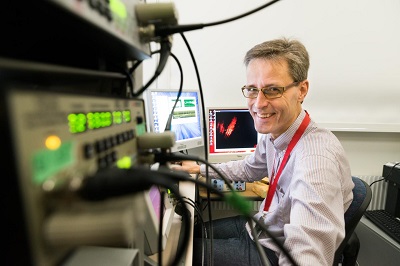LINKÖPING UNIVERSITY - Researchers have found that the parts of the inner ear that process sounds such as speech and music seem to work differently than other parts of the inner ear. Researchers from Linköping University are part of the team behind the discovery.
"This helps us understand the mechanisms that enable us to perceive speech and music. We hope that more knowledge about the capabilities of the ear will lead to better treatments for the hearing impaired," says Anders Fridberger, professor of neuroscience at Linköping University.

Researcher Anders Fridberger in his lab. Courtesy of Thor Balkhed, Linköping University.
To perceive speech and music, you must be able to hear low-frequency sound. And to do this, the brain needs information from the receptors, which are located close to the top of the cochlea, the spiral cavity in the inner ear. This part of the inner ear is difficult to study, as it is embedded in thick bone that is hard to make holes in, without causing damage. Now the international research team has been able to measure, in an intact inner ear, how the hearing organ reacts to sound. The results have been published in PNAS, the Proceedings of the National Academy of Sciences of the United States of America. To measure in the hearing organ, the researchers used optical coherence tomography, a visualisation technology for biological matter that is often used to examine the eye.
"We have been able to measure the inner ear response to sound without having to open the surrounding bone structures and we found that the hearing organ responds in a completely different way to sounds in the voice-frequency range. It goes against what was previously thought of how the inner ear works," says Anders Fridberger.
In addition to Anders Fridberger and Rebecca L. Warren from Linköping University, Alfred Nuttall from the Oregon Health & Science University, and researchers from Imperial College London and the Indian Institute of Technology in Bombay participated in the study.
Source: https://www.eurekalert.org/pub_releases/2016-07/lu-ndo070816.php

